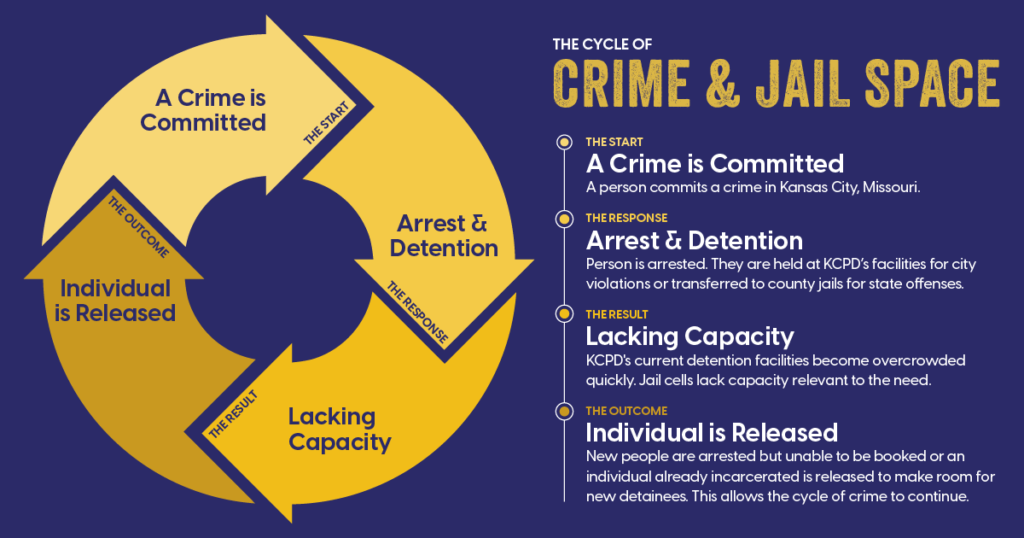In its simplest form, a jail is a place of lawful confinement for individuals in custody. Cities and counties are responsible for providing such a facility, though not necessarily within their own jurisdiction. Some may not fully understand how city and county jails differ in terms of responsibilities and needs, but as Kansas City debates the future of its jails, it’s important to first understand how these systems work within our community.
The City of Kansas City is responsible for housing individuals arrested and charged with violations of city ordinances. These offenses include minor assaults, small-scale thefts, trespassing, DWIs and other traffic violations. In most cases, individuals arrested for these crimes can post bond, with bond amounts initially guided by the city court. If a person cannot post bond, they are held until the court’s next business day. For example, an arrest made on a Friday evening would require holding the individual until Monday morning—or Tuesday if Monday is a holiday.
Currently, KCPD houses these detainees at its own detention facilities until the courts reopen for arraignment. If, after arraignment, the individual is ordered to remain in custody, their confinement would occur at a city jail. However, Kansas City closed its municipal jail in 2009 and now contracts with two counties outside the metro area to house detainees. Similarly, in 2015, KCPD’s centralized detention facility at its headquarters was also closed. That facility had the capacity to hold approximately 100 detainees on a short-term basis. Today, KCPD relies on smaller, less equipped facilities at its patrol division stations, which are not designed for extended detention.
For crimes deemed state offenses—such as murder, aggravated assaults, robbery, sexual assaults, stolen autos and burglaries—the respective county where the crime occurs assumes responsibility for the judicial process. If KCPD arrests a person for such crimes based on probable cause, prosecutors have up to 24 hours, regardless of weekends or holidays, to decide whether to file charges. If charges are not filed within this timeframe, the detainee must be released. During this period, KCPD also houses these individuals, transferring them to the county jail only if charges are filed.
This dual responsibility creates significant challenges for KCPD. The detention facilities at its patrol division stations were designed for short-term holds during booking—typically just a few hours—not for extended stays. These facilities lack basic amenities like showers, beds and hot meals, and their combined capacity is limited to just a handful of detainees. On busy days or weekends, this space is often insufficient, forcing tough decisions.
When there is no available space, officers may be unable to arrest individuals who have committed crimes, simply because there is nowhere to take them. In other cases, those already in custody may need to be released to make room for new arrests. This reality affects both city and county jails alike, highlighting the critical link between crime rates and the capacity of detention facilities.
While debates about the relationship between crime and jail space are valid, one fact is undeniable: the ability to confine individuals is limited by the availability of space. Alternatives to confinement—such as probation, treatment programs or other interventions—are valuable tools, but they rely on the offender’s compliance. If offenders perceive little risk of consequences due to overcrowded jails, the effectiveness of these programs may be diminished.
At any given time, there are individuals caught in a cycle of criminal behavior—a cycle that, left unchecked, often leads to escalating violence. Data and experience show that today’s suspect often becomes tomorrow’s victim. In such cases, incarceration can serve as a critical intervention, providing a “time-out” that may save their life or the life of someone else. Jails, and the capacity they offer, are an essential option for breaking this cycle and protecting the community.
To create a safer Kansas City, we must include jails and their role in our conversations about public safety. Capacity, resources and their place in the criminal justice system are not just logistical concerns—they are fundamental to delivering justice and ensuring community safety. Ignoring this reality limits our ability to plan effectively for a safer future.
President & CEO, Police Foundation of Kansas City



Get Social